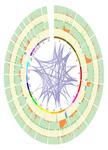版权所有:内蒙古大学图书馆 技术提供:维普资讯• 智图
内蒙古自治区呼和浩特市赛罕区大学西街235号 邮编: 010021

作者机构:Univ Adelaide Dept Genet & Evolut Adelaide SA Australia
出 版 物:《PLOS COMPUTATIONAL BIOLOGY》 (PLoS计算生物学)
年 卷 期:2018年第14卷第4期
页 面:e1006091-e1006091页
核心收录:
学科分类:0710[理学-生物学] 08[工学] 09[农学] 0901[农学-作物学] 0836[工学-生物工程] 090102[农学-作物遗传育种]
主 题:GENOMES NON-coding DNA EVOLUTIONARY theories GENE silencing GENE regulatory networks
摘 要:The forces driving the accumulation and removal of non-coding DNA and ultimately the evolution of genome size in complex organisms are intimately linked to genome structure and organisation. Our analysis provides a novel method for capturing the regional variation of lineage-specific DNA gain and loss events in their respective genomic contexts. To further understand this connection we used comparative genomics to identify genome-wide individual DNA gain and loss events in the human and mouse genomes. Focusing on the distribution of DNA gains and losses, relationships to important structural features and potential impact on biological processes, we found that in autosomes, DNA gains and losses both followed separate lineage-specific accumulation patterns. However, in both species chromosome X was particularly enriched for DNA gain, consistent with its high L1 retrotransposon content required for X inactivation. We found that DNA loss was associated with gene-rich open chromatin regions and DNA gain events with gene-poor closed chromatin regions. Additionally, we found that DNA loss events tended to be smaller than DNA gain events suggesting that they were able to accumulate in gene-rich open chromatin regions due to their reduced capacity to interrupt gene regulatory architecture. GO term enrichment showed that mouse loss hotspots were strongly enriched for terms related to developmental processes. However, these genes were also located in regions with a high density of conserved elements, suggesting that despite high levels of DNA loss, gene regulatory architecture remained conserved. This is consistent with a model in which DNA gain and loss results in turnover or churning in regulatory element dense regions of open chromatin, where interruption of regulatory elements is selected against.